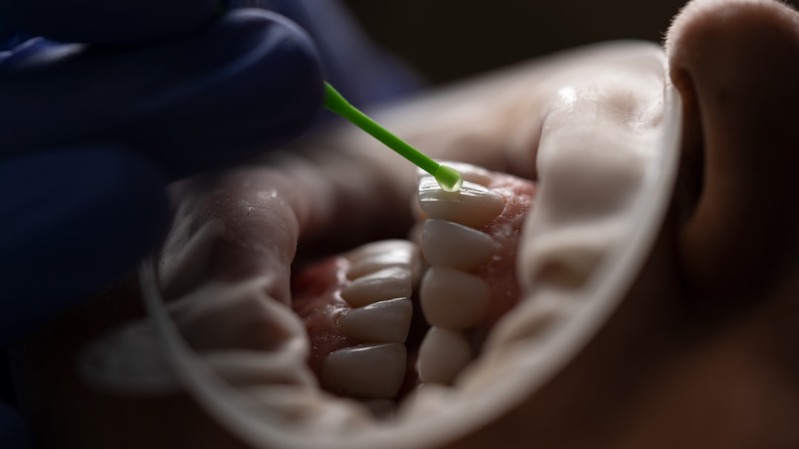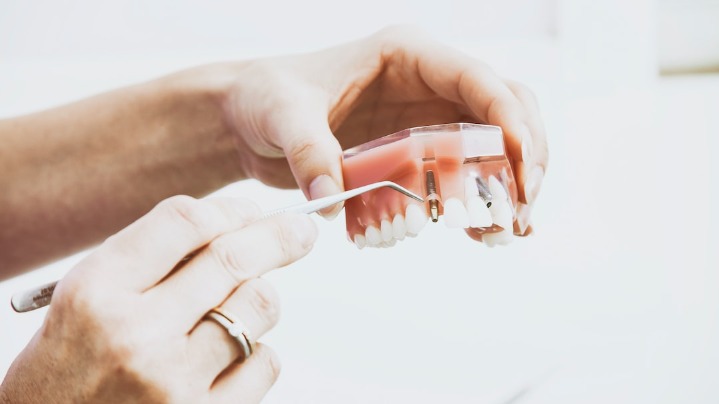
Biomimetic Dentistry
What is Biomimetic Dentistry?
Contents
Biomimetic dentistry is designed to completely avoid all restorative dentistry complications by using the right materials and techniques to mimic your tooth’s structure the first time.
Well-informed patients know natural teeth are the best material for tooth restoration. Reserving the original tooth structure is paramount when teeth require reconstruction due to decay or injury. This is where biomimetic dentistry comes into play.
Biomimetic dentistry is an advanced restoration technique replicating a tooth’s natural shape, form, and function. Unlike traditional dental restoration treatments, this approach utilizes strong, resistant to bacterial infection, and long-lasting materials. As such, many dentists now prefer to suggest it as a solution for providing optimal oral health for their patients.
Biomimetic dentists belong to The Academy of Biomimetic Dentistry. This dynamic group of dentists adheres to the gold standard of Biomimetic Dentistry, which serves as an alternative to traditional dental therapy.
4 Tenets of Biomimetic Dentistry
- High-Tech: Strong, durable, tooth-colored composite tooth restorations are used to restore the problem tooth.
- Ultraconservative: The treatment minimizes cutting to avoid removing too much of the natural tooth structure and to keep a safe distance from the nerve.
- Minimally Invasive: Deep drilling is refrained from, and drilling, in general, is minimized.
- Aesthetic Perfection: Each restoration is a customized work of art that looks and functions like natural teeth.
Biomimetic Dentistry vs. Traditional Dentistry?
Biomimetic Dentistry is a special discipline of dentistry that stems from the philosophy that what the dentist does should preserve and imitate nature as much as possible. Traditional dentistry, referred to as Amputational Dentistry by the Academy of Biomimetic Dentistry, involves restorative materials and procedures that require extensive drilling and breakdown of healthy teeth and tissue to support the creation and application of crowns, bridges, and fillings.
The hallmark of the Biomimetic approach is the effort to preserve as much of the natural tooth as possible and use bonding agents to repair cracks and chips before more damage occurs. Ideally, one takes care of his or her teeth and does not need fillings or tooth replacements, but when the damage is done, a Biomimetic dentist will take the least invasive approach to repair the tooth and prevent further decay.
There is also a strong emphasis on preventative care and maintenance to prevent future problems. Sealants can seal the tooth from bacterial intrusion preventing the need for more invasive fillings and root canal procedures.
Biomimetic Dentists
Biomimetic dentistry is the latest advancement engineered to restore damaged teeth. The art and science behind the technique are that it restores a natural appearance, function, and strength to teeth without the extensive work needed for procedures like root canals.
Mother Nature gives us teeth with properties ideal for protecting them. Unfortunately, that makes restoring them a detailed and expensive process. It’s a delicate procedure, returning teeth to a near-natural state without taking away from their original structure.
Biomimetic dentistry is the result of expansive training and research. Founded in adhesive dental techniques that have evolved since the late 1940s, seeds of biomimetic dentistry’s origin can be found in a library of publications. Still, only the rare, dedicated professional is tracking the advancements in this field. On top of that, only the most advanced dental institution, like the University of Southern California, has put any real effort into incorporating biomimetic dentistry into their curricula. These entities in the dental community seem committed to training new dentists in the advantages of biomimetic dentistry and teaching techniques supported by peer-reviewed scientific research.
- Eliminating the need for root canal therapy
- Imitating nature by replacing teeth in layers
- Significantly reducing tooth sensitivity after dental work
- Saving time with the completion of dental work in one office visit
- Preserving more of your original tooth
Biomimetic dentistry operatives can conserve as much tooth structure as possible. It preserves the vitality of the tooth, restoring teeth without requiring operations like root canals or tooth extraction. It increases the bond strength of teeth by 400 percent and minimizes shrinkage stress on teeth. Biomimetic dentistry has managed long-lasting restoration, eliminated sensitivity, and prevented complications associated with conventional dental work.
The Tooth Death Spiral in Dentistry
Caring for teeth the old-fashioned way does as much harm as it does good. Fixing one problem contributes to another. Dentists who practice biomimetic dentistry call this “the tooth death spiral”. The word death here is an ode to what indeed happens: the tooth dies.
The Tooth Death Spiral explains the process that old-fashioned dentistry uses.
- A tiny cavity is found. The dentist fills the cavity.
- The silver amalgam filling is used to fix the cavity, but part of the natural tooth must be removed to ensure the filling stays intact. This drastically decreases the tooth’s natural strength.
- Because the tooth’s natural structure has been taken away from it, over time, the tooth ultimately fractures.
- After the tooth fractures, the only way to fix it is through performing a root canal, post, and core, so that the tooth won’t fracture again.
- The root canal is successful, but the tooth is as good as dead.
- After root canals are performed, the teeth are way too strong. They do not maintain any of their original composition. They are permanently damaged.
- Because teeth are too strong after root canals, their unnatural weight presses down even below the crown, ultimately resulting in the tooth dying.
- The dentist removes damaged teeth and installs an implant where the tooth was. A dentist who uses biomimetics could have saved the tooth (or teeth!) from being killed by unnatural substances.
Biomimetic Approach Avoids Root Canals
One of the most common and painful oral health problems people encounter is when an oral infection spreads to the tooth’s interior, resulting in the need for a root canal.
In a traditional root canal procedure, a dentist drills into the tooth and removes all of the infected tooth pulp, including the nerve, and fills the empty space with a rubbery type substance before placing a crown that adheres to the external tooth structure. In the biomimetic approach, a dentist does less drilling, leaving the nerve and some inflamed tooth pulp intact.
The biomimetic premise for leaving some of the inflamed tooth pulp intact is that the infection requires access to oxygen and certain particles in sugar and other chemicals it feeds off of to grow and cause further damage. By creating an air-tight seal that prevents the infiltration of sugar and air, the bacteria causing the infection becomes dormant. Because the remaining tooth pulp and nerve are still there, they can heal and regenerate naturally.
Biomimetic Principles for Crowns
To fully understand what biomimetic dentistry can do, let’s look at traditional crown preparation. To perform a restoration, 75 percent of a tooth will be removed. This is a complicated process but is required for success. For a crown, there would have to be almost nothing left of the tooth, guaranteeing a root canal.

On the other hand, with biomimetic dentistry, a structurally compromised tooth is saved by leaving the remaining tooth structure intact and building a biomimetic restoration.
The potential 400 percent increase we could achieve through biomimetic dentistry is critical to success. Combining the restoration to a tooth with the exacting strength of natural enamel will revolutionize how the dental world manages damaged teeth. The lasting performance of a return to maximized bond strength means the tooth will last longer and be resistant to fractures and chipping. Teeth will be stronger, and patients will have healthier oral lives.
Biomimetic Principles for Implants
Taking care of your mouth has become more manageable thanks to biomimetic dentistry. This method promotes tooth-conserving dentistry and aims to extend the lifespan of natural teeth. Biomimetic methods help dentists learn how to properly detect and remove caries and practice the conservative restoration of the tooth structure to ensure that it still resembles the appearance of a natural tooth.
When it comes to dental implants, osseointegration is one of the most popular methods in the dental industry today. Osseointegration is surgically integrating and anchoring an artificial implant into the bone that grows into the implant. The bone healing procedure around dental implants (usually using titanium) involves biological events that mimic natural bone healing and are regulated by many growth and differentiation factors.

Titanium is widely used in osseointegration because of its durability and biocompatibility. Moreover, the surface characteristic of dental implants complements the features of titanium and influences the progress and success of the osseointegration. The more natural the materials used in the integration process, the easier it’ll be for dental implants to mimic the bone matrix in the mouth.
Several studies suggested that the titanium surface condition used in osseointegration can be improved using surface coating with osteoconductive compounds (e.g., hydroxyapatite and calcium phosphate) and biomolecules. According to studies, this method encourages the new bone formation and accelerates bone formation.
Additionally, studies also supported that coating implants with biomolecules can accelerate the initial health times of the mouth during the integration of the dental implant. As a result, this process can reduce overall treatment times and increase the success rates of implants.
Utilizing pharmacologic agents like bisphosphonates is also an excellent way to improve bone density in highly cancellous bones. Because these materials are biocompatible, using them to coat implants increases the ability of the implant and bone to integrate.
Because of its many benefits, it’s no surprise that biomimetic dental implants are catching up as the next big thing in restorative dentistry. With biomimetic dental implants, patients and dentists will see that preserving the natural structure of the teeth will result in greater longevity and better health of the natural teeth. This procedure provides tremendous economic benefits for both patients and dentists.
5 Reasons Why Biomimetic Dental Restorations
Biomimetic dentists aim to preserve as much of a tooth’s natural structure as possible. The last thing I want for my patients is an expensive dental repair that will leave them at greater risk for the breakdown of a tooth or an infection down the road.
The biomimetic dental treatments I use at my practice mimic natural teeth as much as possible, and along the way, every effort is made not to compromise the tooth further.
Any patient on the fence about a dental restoration procedure can take comfort in knowing that the biomimetic dentistry options available are safe, effective, and reliable. The following are five reasons why biomimetic dental restorations are your best choice:
1. Nature Serves as Our Guide
Biomimetic dentistry means life-like. This approach to dentistry looks to nature (the greatest designer) to copy what it has produced. It looks to restore what was naturally strong and return it to its original properties.
2. Inside-Out Approach
Biomimetic dentistry approaches your teeth from the inside out. It helps protect your existing teeth against bacteria and seals against infection.
3. Repair, Don’t Replace
Biomimetic dentistry seeks to repair what you currently have rather than removing more of your natural tooth to install replacement components. A repair, such as bonding, is not always an option, but if it is, it is the preferred method.
4. It’s Cost-Effective
Biomimetic restorations are more cost-effective than traditional restorations. They require fewer repairs over their lifetime. This saves you extra dental visits to dental offices.
5. Long-Lasting Success
Because biomimetic-repaired teeth rarely need a root canal or traditional crown, they have high long-term success rates. While maintaining a more natural tooth structure, your tooth remains healthier for longer.
How can biomimetic dentistry and minimally invasive procedures help you? Contact a Biomimetic dentist today to learn how this approach can brighten your smile and restore your teeth.

